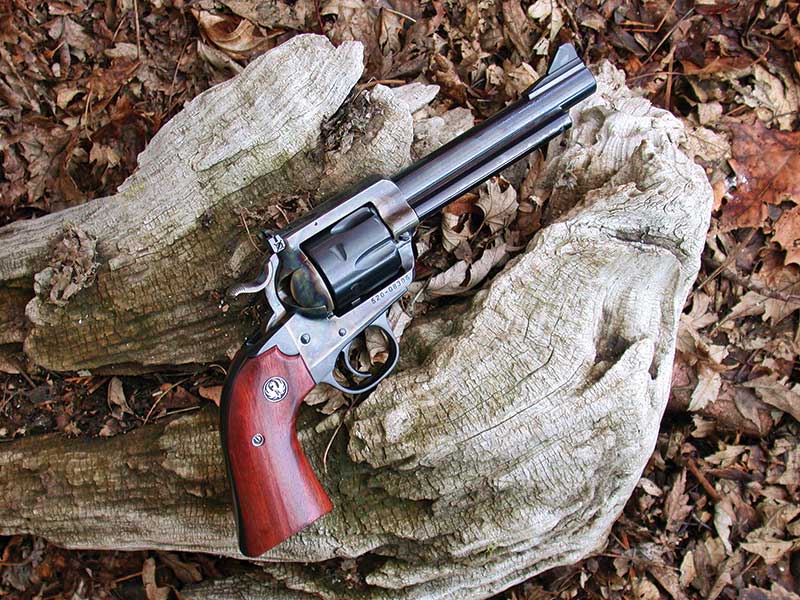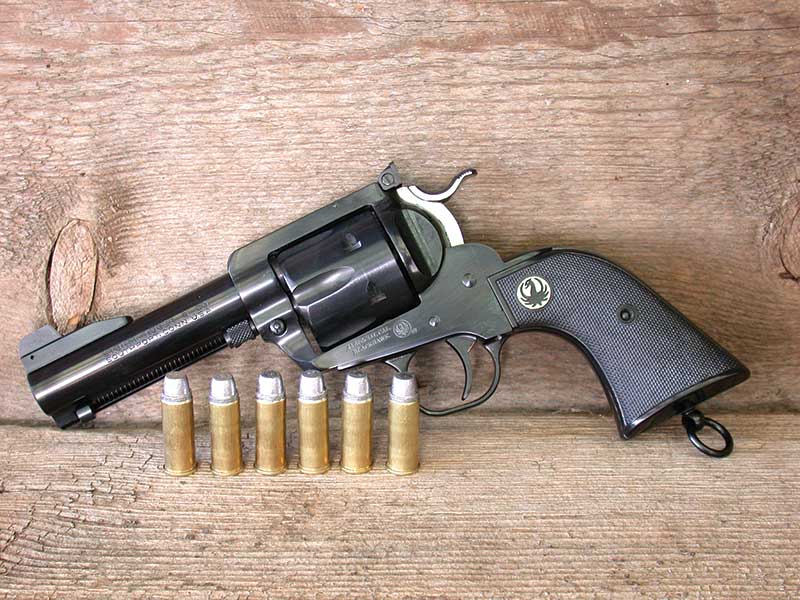SUPERBLY SUITABLE
A Centennial Salute To The Special
In 1925, Elmer Keith blew the cylinder and top strap on a heavily loaded .45 Colt Single Action and a new career was launched as the incident became Keith’s first handgun article for The American Rifleman.
He then switched to the then relatively unknown (except to true connoisseurs) .44 Special and, from the late 1920s until 1955, Keith continually promoted the .44 Special as the ideal sixgun cartridge using his designed “Keith” bullet weighing 250 grains and pushed at 1,100 to 1,200 fps using first No. 80 powder and, when it became available, Hercules No. 2400.
Keith’s four Colt Single Action .44 Specials were a King short-action job with 71⁄2″ barrel, an original one-of-a-kind 71⁄2″ Flattop Target, the No. 5 SA Colt, an extensively customized 51⁄2″ Flattop Target Model with a special grip made by combining a Bisley back-strap and Colt SA trigger guard and a 51⁄2″ converted to a Flattop Target with Keith-designed folding 3-leaf rear sight.
For much of his adult life Keith lived on the Salmon River in Idaho working as a guide, packer, out-fitter, big game hunter and the Colt Single Action .44 Specials were his everyday working tools. In the 1950s, Keith switched from his beloved Single Action Colts.
When he moved into town, he began to carry a 4″ 1950 Target Smith & Wesson .44 Special as his favorite sixgun. As far as Keith was concerned the .44 Special was the King of Sixgun Cartridges and he asked ammunition and firearm manufacturers to bring out a “.44 Special Magnum” and the result, finally, in late 1955 was the Smith & Wesson .44 Magnum. Keith retired his .44 Specials and carried a .44 Magnum until his stroke in 1981.
In 1966 Smith & Wesson dropped the 1950 Model Target .44 Special and then Colt followed by removing the .44 Special as a Single Action Army and New Frontier chambering. In one short brief span of time all full-size .44 Special sixguns disappeared. The .44 Special for all intents and purposes was dead, and what had started with the S&W Triple-lock in 1907 was now gone, buried and forgotten except by we dedicated few. The only man who both really appreciated the .44 Special and was in the position to rectify the situation was Skeeter Skelton and that is exactly what he did.
If there weren’t any .44 Specials to be had from Colt and Smith & Wesson, the only solution was make your own. Starting with a Ruger .357 Blackhawk, the 3-Screw Old Model as it is now referred to (the same size as the Colt Single Action), and a Smith & Wesson Model 28 Highway Patrolman .357 Magnum, Skeeter set about to have both converted to .44 Special. The .44 Special was back among the living. With his one article in the early 1970s covering these two conversions, Skeeter single-handedly resurrected the .44 Special and custom sixgunsmiths have been kept busy doing such conversions ever since.
Today the .44 Special is alive and well. Enough so Smith & Wesson offers the 4″ Model 21-4 fixed-sighted .44 Special, Freedom Arms’ Model 97 is one of the finest .44 Special sixguns ever produced and USFA chambers Single Action and Flattop Targets in the 100-year-old Special. In addition to these fine .44s, I am personally acquainted with .44 Special conversions by at least eight sixgunsmiths, all top-quality custom work. No gunsmith living today, or even those who modified Keith’s .44 Specials in the 1920s and 1930s can surpass Hamilton Bowen when it comes to building beautiful sixguns. Over the years I’ve had Hamilton put together five .44 Specials on 3-Screw Ruger .357 Blackhawks all of which have become family heirlooms.
Blackhawk Redux
Ruger introduced their first centerfire single action, the .357 Blackhawk now known as the Flattop in 1955. With its flattop frame, adjustable rear sight, coil spring powered action, and chambered in .357 it was almost the perfect single action. The only thing needed to complete perfection was for it to be chambered in .44 Special. This surely would have happened had not the .44 Magnum arrived one year later. Instead of offering the .357 Blackhawk in .44 Special Ruger chose to enlarge the frame of the Blackhawk and chamber it for the .44 Magnum.
Fast forward 50 years and Ruger introduced the Anniversary Model .357 Blackhawk using the New Model transfer bar action while reverting back to the flattop frame of the original as well as the same size and shape grips found on the 1955 Blackhawk. Hope springs eternal within this savage breast and I have talked with the president of Ruger, Steve Sanetti, twice about keeping this Blackhawk in the catalog as well as bringing it out in .44 Special. He did not say no, however at least up to this time he has not said yes. That brings us down to two of the finest .44 Specials in existence both by Hamilton Bowen and both built on Ruger’s 50th Anniversary .357 Blackhawk.
Why? Pray Tell
Some, especially late arrivals to the sixgunnin’ scene, might well ask what’s so special about the Special?We’ve had the .44 Magnum for more than half a century now and it has been followed by the .454 Casull, .475 and Wyoming Express, and the .460 and .500 S&W Magnums. These are all superb cartridges, very accurate and powerful. Any one of them can handle anything anyone could want to hunt.
When it comes to pistol power, whether signified by muzzle energy or Taylor’s Knock Out formula, they all leave the .44 Special far behind. Life is full of trade-offs and big-bore Magnums deliver heavy felt recoil and significant muzzle blast. The joy of the .44 Special is a lighter, easier to pack sixgun and, when loaded with 250-grain bullets at 900 to 1,000 fps, it is still very pleasant shooting and able to handle about 99 per-cent of the chores any sixgun is called upon to do. I am not about to toss all my big-bore Magnums on the bone pile, however, after getting beat up by them the .44 Special is definitely the pause that refreshes. It was my first true love a half-century ago and I find myself spending more time with it now than ever.
A “Special” Special
As a salute to the 100th anniversary of the .44 Special, Hamilton Bowen’s two single action revolvers are perfect exam-ples of what a .44 Special sixgun should be. Both the original Flattop .357 Blackhawk and the 50th Anniversary version are smaller in frame and cylinder size than all Ruger Blackhawks built since 1972, and are the same basic size as the Colt Single Action Army. This makes them perfect platforms for the .44 Special. In addition to capturing the flavor of the original Blackhawk, the Anniversary Model is also built on the transfer bar New Model action making it safe to carry fully loaded with six rounds. Until 1972 all Rugers were traditionally-styled single actions requiring carrying them with an empty chamber under the hammer.
Bowen’s first New Model conversion is dubbed the Kenai. It is re-chambered to .44 Special, fitted with a 4″ barrel, a Weigand combat front sight with a white-lined Hi-Viz blade and matched up with a Bowen Rough Country heavy-duty rear sight. A Bisley hammer is fitted, the recoil shield and loading gate are scalloped to cut weight and give a classic appearance, an oversize locking base pin is installed and, for security and just plain good looks, a lanyard ring is added. Bowen says such a conversion on the new Flattop Blackhawk is perfect as a .44 Special “walking around gun.” I agree!
The Game
I don’t like playing the “What would Elmer Keith think?” game, however I do believe Keith would consider this second Bowen conversion an even better sixgun than his No. 5 SA. For this .44 Special Bowen uses a 51⁄2″ barrel, custom front sight, oversize locking base pin, beautifully colored cased frame, hammer and loading gate with a Ruger Bisley grip frame and trigger. As with the Kenai, this one also is totally tuned to perfection. With the smaller frame and lighter weight of the Anniversary Model this conversion feels quite different than the larger frame Bisleys. It balances and points superbly for me.
Perfect loads for perfect sixguns such is these are easily assembled using Keith-style 250-grain hard-cast bullets over 7.5 grains of Unique, Universal, or Power Pistol. Muzzle velocities will be around 950 fps depending upon barrel length, are amply powerful for most uses, and will not beat up the shooter. Skeeter Skelton would surely smile on such .44 Special sixguns as these.

Get More Revolver Content Every Week!
Sign up for the Wheelgun Wednesday newsletter here:





